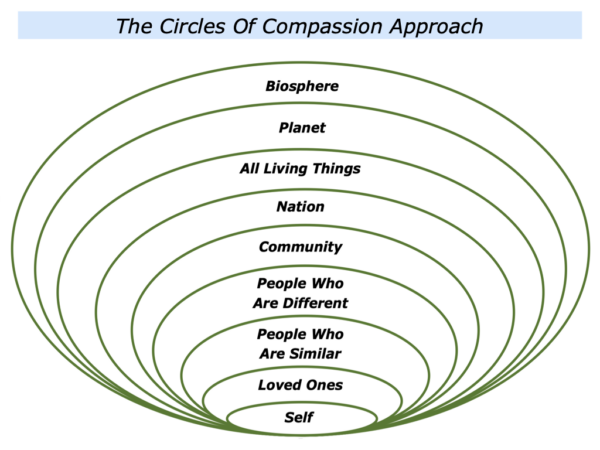
Different people show caring for others in different ways. They may demonstrate sympathy, empathy or compassion. Compassion is translating caring into action.
This has led to people creating the circles of compassion approach. This starts with the individual at the centre of the circle and them also having compassion for their loved ones.
Some individuals have compassion for people who are similar to them. Some have compassion and respect for people who are different from them. The extent to which we have compassion can govern our actions.
Some people have love and compassion for their community. Some for their nation. Some for all living things. Some for the whole planet. Some believe it is vital to care for the life-giving forces of the whole biosphere.
Jeremy Rifkin built on the circles of compassion approach in his book The Empathic Civilization. In it he describes how the future of humanity may depend on us extending our empathy to the entire human family and the biosphere.
This RSA Animation brings to life many of Jeremy’s ideas.
Some people seem to have a compassionate gene that is strongly developed. Many people who go into the caring professions – such as nursing – often demonstrate this approach.
People who show compassion often have a history of being loved and being taught to respect other human beings. As the saying goes:
Love is like many things in life. If you don’t learn it early, it is much harder to learn it later.
The same can be said for compassion. People who learn it early are more likely to show it later. At the same time, however, some people choose to show compassion as they get older.
William Ross Wallace alluded to this approach in a poem he published in 1865. This later became known as The Hand That Rocks The Cradle Is The Hand That Rules The World.
This emphasised the influence that mothers and fathers had on a child. The love – or lack of it – the child received then could affect their character later in life. Let’s explore some of the ways that people may express these themes.
The Charter For Compassion
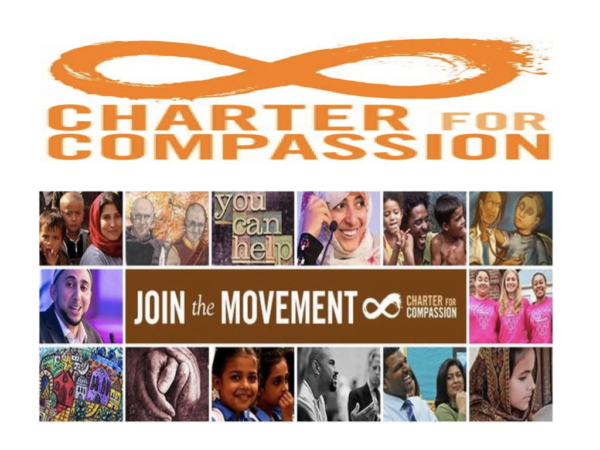
Karen Armstrong focused on this theme in her TED talk that led to creating the Charter for Compassion. She believes it is vital to start from the heart and create hope rather than spread division. Here are some excerpts from the Charter.
The principle of compassion lies at the heart of all religious, ethical and spiritual traditions, calling us always to treat all others as we wish to be treated ourselves.
Compassion impels us to work tirelessly to alleviate the suffering of our fellow creatures, to dethrone ourselves from the centre of our world and put another there, and to honour the inviolable sanctity of every single human being, treating everybody, without exception, with absolute justice, equity and respect.
It is also necessary in both public and private life to refrain consistently and empathically from inflicting pain.
To act or speak violently out of spite, chauvinism, or self-interest, to impoverish, exploit or deny basic rights to anybody, and to incite hatred by denigrating others – even our enemies – is a denial of our common humanity.
We acknowledge that we have failed to live compassionately and that some have even increased the sum of human misery in the name of religion.
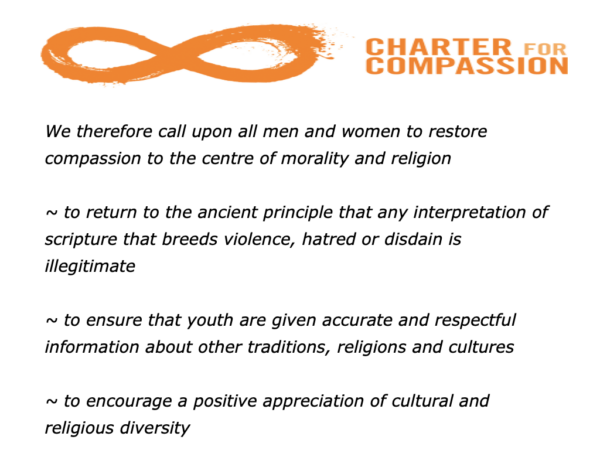
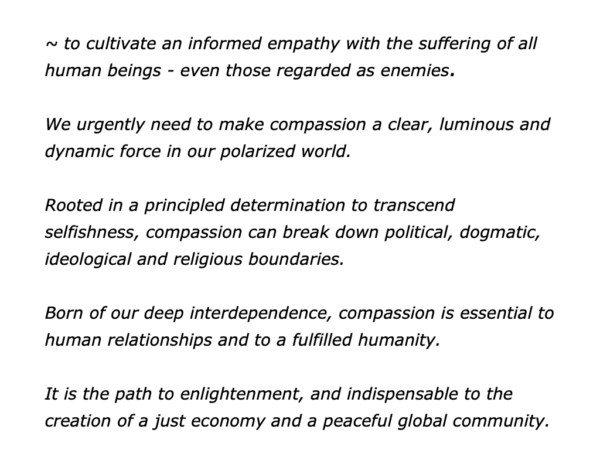
Karen’s work led to creating a board of Trustees who aim to translate the Charter for Compassion into action. Here is an excerpt from the website.
Compassion is at the root of many religions and spiritual beliefs. So let’s revive the Golden Rule.
Always treat all other people with the respect that you would like them to treat you with. Do not cause pain to others that you would not like inflected on yourself.
Compassion can help to build a global community that helps to achieve the common good. We believe a compassionate world is a peaceful world.
We believe a compassionate world is possible when every man, woman and child treats others as they would wish to be treated – with dignity, equity and respect.
We believe all human beings are born with the capacity for compassion, and it must be cultivated for human beings to survive and thrive.
The Greater Good Center –
The Importance Of Compassion
The Greater Good Center, based at the University of California, Berkeley, focuses on the science of living a meaningful life. Here are excerpts from part of its website that is devoted to compassion.
Compassion is not the same as empathy or altruism though the concepts are related.
While empathy refers more generally to our ability to take the perspective of and feel the emotions of another person, compassion is when those feelings and thoughts include the desire to help.
Scientific research into the measurable benefits of compassion is young. Preliminary findings suggest, however, that being compassionate can improve health, wellbeing, and relationships.
Many scientists believe that compassion may even be vital to the survival of our species, and they’re finding that its advantages can be increased through targeted exercises and practice.
Compassion makes us feel good.
Compassionate action (e.g., giving to charity) activates pleasure circuits in the brain, and compassion training programs, even very brief ones, strengthen brain circuits for pleasure and rewards and lead to lasting increases in self-reported happiness.
Being compassionate – tuning in to other people in a kind and loving manner – can reduce risk of heart disease by boosting the positive effects of the Vagus Nerve, which helps to slow our heart rate.
Brain scans during loving-kindness meditation, which directs compassion toward suffering, suggest that, on average, compassionate people’s minds wander less about what has gone wrong in their lives, or might go wrong in the future; as a result, they’re happier.
Compassion helps make caring parents: Brain scans show that when people experience compassion, their brains activate in neural systems known to support parental nurturance and other caregiving behaviors.
Compassion helps make better spouses: Compassionate people are more optimistic and supportive when communicating with others.
Employees who receive more compassion the workplace see themselves, their co-workers, and their organization in a more positive light, report feeling more positive emotions like joy and contentment, and are more committed to their jobs.
More compassionate societies – those that take care of their most vulnerable members, assist other nations in need, and have children who perform more acts of kindness – are the happier ones.
Compassionate people are more socially adept, making them less vulnerable to loneliness.
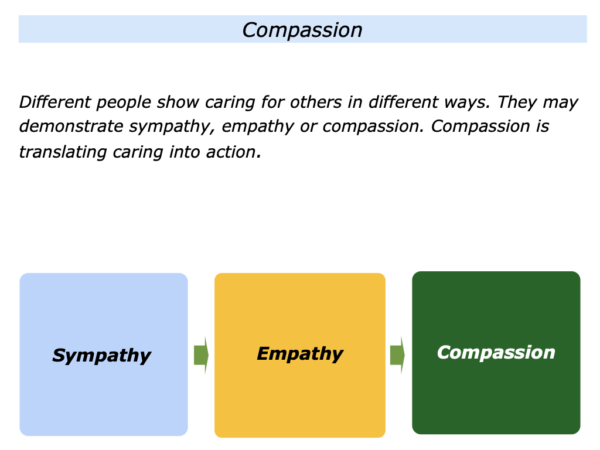
Compassion In
Challenging Situations
Compassion can produce enormous benefits, both for ourselves and other people. It can help us to shape a positive future.
Certainly it is possible to show compassion and become a victim, but that does not help anybody. At the same time, however, it is important to recognise that there may be big things at stake.
Marjorie Clifton describes this approach in her article called Grace Under Pressure: Why difficult situations speak the most about you. She begins it with the following statement.
When my grandfather was once asked by a banker whether a dear friend of his of 20 years was trustworthy, he famously said, “I don’t know, I’ve never seen his back against the wall.”
I always wondered what he meant; after all, he had known the guy for most of his life. But, as a professional, and now a parent, I am acutely more aware of what he was really saying.
Marjorie goes on to share ideas about how people can respond when faced by a difficult scenario. Here are the headline themes.
Take a breath (or a walk) before you react … If you have any hesitation, phone a friend … Give people the benefit of the doubt … Consider the long-term impact … Take the high road, even when it hurts.
Compassion can uplift others and can also lead to longer-term feelings of happiness. Emma M. Seppala explores this theme in her article The Best Kept Secret to Happiness: Compassion. Here are some excerpts from this piece.
Compassion and service don’t just make us happy but they also have a host of other associated benefits and may even contribute to a longer life.
One reason compassion makes us happy is by broadening our perspective beyond ourselves. We know from research on anxiety and depression that these tense and unhappy states are highly self-focused.
When you do something for someone else, however, that state of self-focus immediately dissolves … All of a sudden your attention was on helping them.
Rather than feeling blue, you began to feel energized and before you knew it, you may even have felt better and had gained some perspective on your own situation as well.
Compassion Uplifts And Spreads
Why are the lives of people like Mother Teresa, Martin Luther King, and Desmond Tutu so inspiring?
Research by Jonathan Haidt at the University of Virginia suggests that seeing someone helping another person creates a state of elevation.
Have you ever been moved to tears by seeing someone’s loving and compassionate behavior?
Haidt’s data suggests that it may be this elevation that then inspires us to help others – and it may just be the force behind a chain reaction of giving.
Social scientists James Fowler of UC San Diego and Nicolas Christakis of Harvard demonstrated that helping is contagious – acts of generosity and kindness beget more generosity in a chain reaction of goodness.
What can we take away from this research? That material goods may give us fun short-term pleasure but that long-term happiness and fulfilment lies less in what we can take than what we can give.
Compassion may just be the best kept secret to being not just happy but also healthy, wealthy, and wise.
Let’s return to your own life and work. Looking ahead, can you think of a situation where you may want to follow elements of the compassionate approach?
You may want to do this by encouraging a loved one, friends or kindred spirit. You may wish to do it by showing respect and caring for somebody who is different. You may wish do something practical to care for living things or the planet.
If you wish, try tackling the exercise on this theme. This invites you to complete the following sentences.
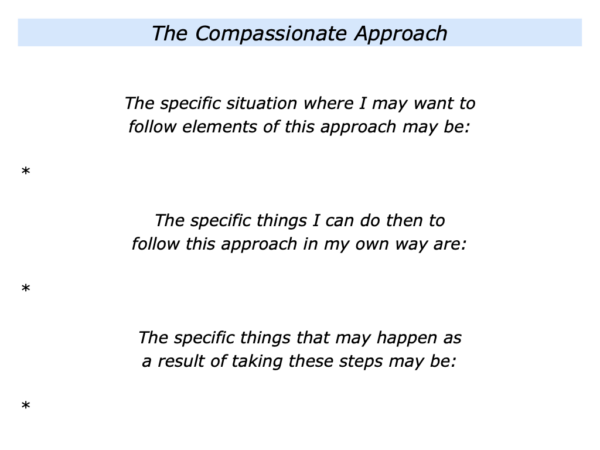






Leave a Reply